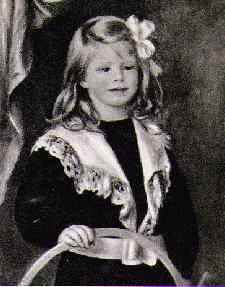
Figure 1.--Renoir painted his son Jean in 1901 with the boy in a ' Fauntleroy suit. French boys often wore long hair, but it was not commonly done into ringlet curls.

Note: I am unsure as to how to classify stylistically many of the artists
discussed here. Please let me know if you have any insights and suggestions.
Paintings with information on boy's fashions have been painted in many
different styles. Some were highly realistic paintings, almost like photographs.
Many of these, especially in the mid-19th Century offer more detailed
information from the still developing photography and before the 1840s there were
no photographic images. Even after the commercial
development of photography in the 1840s, it is paintings that
provide details on color as well as settings in context that provide
valuable insights into fashions and how they were worn. Photography
until the turn of the 20th Century was generally limited to a
photographer's studio. Out door scenes and activity images were still all
paintings. Other paintings were impressionistic or abstract art which provide
much less detail, but still fascinating images of boys' fashions.
Some of the different styles include:

Figure 1.--Renoir painted his son Jean in 1901 with the boy in a ' Fauntleroy suit. French boys often wore long hair, but it was not commonly done into ringlet curls. |
The impressionists provide us some wonderful images of late 19th Century
fashions. Although photography was being perfected, there were no color
photographs and very few realistic images showing activities and relationships.
Most photographs were artificially posed, static images.
Renoir's predilection towards
gay, light-hearted themes was
also influenced by the great Rococco masters. Renoir endured much hardship early in his career, but he began to achieve success as a portraitist in the late 1870s and was
freed from financial worries after the dealer Paul
Durand-Ruel began buying his work regularly in 1881. These portraits
include several family portraits illustrating children's clothes.
By this time Renoir had 'traveled as far as Impressionism could take me', and a visit to Italy in 1881-82 inspired him to seek a greater sense of solidarity in his work. The change in attitude is seen in The Umbrellas (NG, London), which was evidently begun before the visit to Italy and finished afterwards;
the two little girls on the right are painted with the feathery
brush-strokes characteristic of his
Impressionist manner, but the figures on the left are done in a
crisper and drier style, with
duller coloring. After a period of experimentation with what he called
his `manireaigre' (harsh or sour manner) in the mid 1880s, he developed a
softer and more supple kind of
handling. Renoir is perhaps the best-loved
of all the Impressionists, for his subjects---pretty children, flowers,
beautiful scenes, above all lovely women---have instant appeal, and he
communicated the joy he took in them with great directness. `Why
shouldn't art be pretty?', he said, `There are enough unpleasant
things in the world.' He delighted in painting his sons. Most
of those paintings were executed when the boys were younger and wearing
dresses and smocks or fancy Fauntleroy suits. They provide a good
idea of French boys clothes in the late 19th and early 20th Centuries.
One of his sons, who was a particularly favorite subject was the
celebrated film director Jean Renoir (1894-1979), who wrote a lively and touching biography
(Renoir, My Father) in 1962.
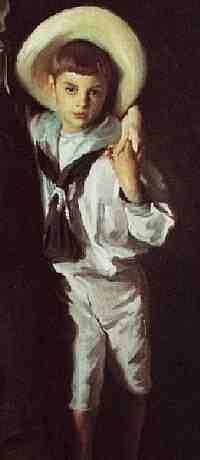
Figure 2.--This 1890 painting by John Singer Sargent was one of the artist's many masterful portraits. The boy is Livingston Davis who wears a white summer sailor suit and wide-brimmed hat. |
Sargent is known
for his dazzling and often daring portraits of British and
American high society at the turn of the century. Most of his best
known works are glamorous portraits of
eminent or socially prominent people of the period and helped to shape our
view of the era. At first he was considered to modern and to French in both
England and America, but he was eventually sought after by the rich and
famous. He is now widely regarded as the leading portrait painter of
his generation. He showed remarkable technical precocity as a painter.
Sargent was often criticized for what some believed
to be a superficial brilliance and his portraits were largely dismissed
after his death. In more recent years, however, Sargent's works
have been acclaimed for their naturalism and masterly technical skill.
Sargent's work, unfortunately, includes few portraits of boys. Thus
while there are many portraits illustrating the dress of women, girls, and
men, there are only a few of boys to illustrate fashions in the late
19th and early 20th Century. The two most interesting are Livingston
Davis in a white sailor suit (1890) and ??? Meyer in a grey velvet jacket
and ruffled collar (18??). For those of us who
beauty in art, Sargent's legacy are paintings of dazzling technical
skill, often showing radiantly beautiful images of the Gilded Age.
Gauguin was one of the foremost painters of the Post-impressionist
movement. He was born in Paris. His father was a journalist from Orleans. His
mother was partly Peruvian. He had a cosmopolitan childhood, growing up in Lima,
Orleand, and Paris. He was a seaman, served in the French Navy during the Franco-
Prussian War, and worked as a stock broker and successful back agent. He did not
begin to paint until 1873 after his marriage. He exhibited his first work in 1876
and begun to revolutionize modern art. I only know one boy he painted, the son of
a friend, but it is a wonderful piece.
English portrait
and historical painter born in Southhampton. He exhibited at the Royal
Academy when he was only 17 years old. His Pizarro Seizing the Inca
of Peru is considered on of the best historical works shown. He
became associated with the Pre-Raphaelites, including Dante Gabriel
Rossetti and Holman Hunt. His first Pre-Raphaelite painting was a
scene from the Isabela of Keats, recalled the manner of the early
Flemish and Italian masters. He married Euphenmia Gray in 1855. He
was elected an associate of the Royal Academy in 1856. Other major works
include Chill October (1871), The Northwest Passage (1873),
and Effie Deams (1877). His work includes several portraits of
children, providing fascinating glimpses of the clothes worn by wealthy
children during the second half of the 19th Century. Millais was
created a baronet by Queen Victoria in 1885 and elected president of the
Royal Academy in 1896. There's a new exhibition of Millais
portraits in London during 1999. One critic in reviewing the exhibit
bemoaned how the painter abandoned the pre-Raphaelites to paint society
portraits including "sickly sweet portraits of children."
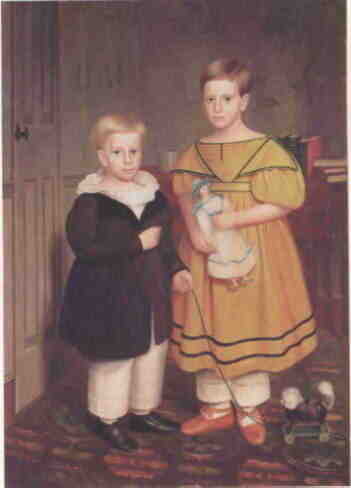
Figure 3.--This unidentified American primitive shows the pantalettes worn by young children with tunics and dresses. Some like these were plain, others were much more fancy. |
American primitive artists provide wonderful color images of fashions in Colonial America and the early 19th Century before the development and commercial success of photography. The British refer to this art as "naive". These artists generally had no academic training aat all. Some traveled the bavkrodes of rural America and sometimes painted a portrait for room and board. Others had studios in the still small cities in America duting the late 18th and early 19th century. Often the artist is not known, especially many of the works done by itenerate artists. Many other American primitive artists are known. These paintings are one of the principal sources of information on what American boys were wearing in the early 19th century. They are particularly important in an age that clothes were still hand maid and thus there could be substantial variations. While these paintings look primitive because of the child-like perspective, their portraits include very detailed and accurate depictions of clothing.
Helen Allingham (nee
Paterson) was born near Burton on Trent, the family settling in Birmingham
after the death of her father in 1862. She studied at the Birmingham School
of Design. She is recognized as an important English watercolor painter in the
late 19th and early 20th Centuries. Most of her work is exteriors, but
a few are of her children, often in formal clothes. This provides a rare
insight into play clothes in the late 19th Century as most of the available
portraits and photographs show the children in their dress party clothes.
I am just beginning to identify the styles involved. Please let me know how you would
classify the various artists:
Billy, Louis Leopold (France,
1761-1845): French genre and portrait painter, born at La Russe.
He was much influenced by the Dutch genre painters. Notable among the
incredible 5,000 paintings and drawing credited to him is The Arrival
of the Diligence (Louvre, 1803). Some of his paintings and real life scenes
provide interesting glimpses of French boys' fashions of his time.
Boldini, Giovanni (Italy,
1845-1931): Italian genre and portrait painter. He was born in Ferrara and
educated at the Academy of Florence. He achieved success at a young age painting
portraits in London, but he moved to Paris in 1872. He was a good friend of the
American painter Whistler.
Gainsborough, Thomas (England, 1727-88):
Thomas Gainsborough is one of the most renowned portrait painter. He
developed the subject-matter of small portrait groups, set in a realistic
landscape. Two his most famous portraits are The Blue Boy (1770) and
Pink Boy (17??). The boys, one a relative of Gainsbourough, were
painted in elaborate satin and lace costumes of the previous century.
His early works show
the influence of French engraving and of Dutch landscape painting; at
Bath his change of
portrait style owed much to a close study of van Dyck (his admiration is
most clear in The Blue Boy. By the 1780s Gainsborough and his rivals, Joshua
Reynolds and Allan Ramsay, were considered to be the best portrait painters
in England. All three
painted George III but it was claimed that the royal family preferred
Gainsborough's portraits.
Goya y Lucientes, Francisco Jose de (Spain,
1746-1828): Goya is along with El Greco and Velasquez, is one of the three
great pillars of Spanish art. Goya addressed many different genres and styles.
He was the court painter to Charles IV. He is widely known for his portraits of
Spanish
nobility, including boys, but he also painted many accomplished scenes of modern
life.
Greuze, Jean-Baptiste (France, 1725-1805):
Jean Baptiste Greuze was a French genre and portrait painter. Greuze was an
eminent portraitist. Among his most famous portraits are those
of the Dauphin, the ilfated son of King Louis XVI, Robespierre, Napoleon,
as well as numerous political and artistic figures. Few
portraitists painted such a diverse list of subjects. Some of his most striking
portraits are the heads of anonymous children and young women.
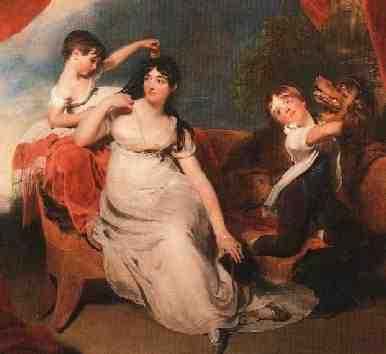
Figure 4.--. |
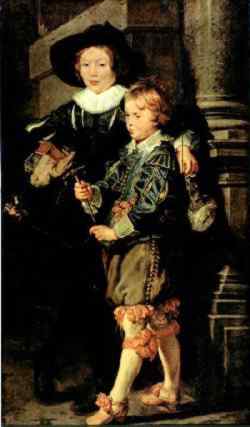
Figure 4.--This portrait Rubens portrait of his sons Albert and Nicholus was painted about 1625. |
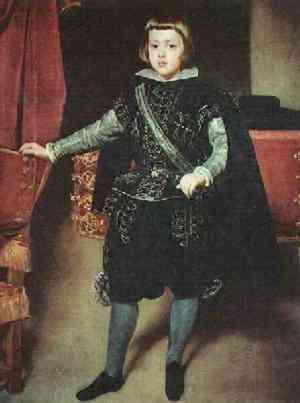
Figure 5.--This portrait of Don Baltazar Carlos was painted by Spanish master Velazquez about 1635. |
Navigate the Boys' Historical Clothing artistic pages:
[Return to the Main artistic page]
[Chronologies]
[Individuals]
[National]
[Styles]
Navigate the Boys' Historical Clothing Web Site:
[Introduction]
[Chronology]
[Clothing styles]
[Biographies]
[Bibliographies]
[Activities]
[Countries]
[Contributions]
[Boys' Clothing Home]